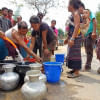The Sundarbans' plight

On World Water Day, a stark reality hangs heavy in the air: over two billion people lack access to safe drinking water, facing a daily struggle for this fundamental human right. This crisis transcends borders, impacting communities worldwide. The Sundarbans, a Unesco World Heritage Site nestled in the Ganges, Brahmaputra, and Meghna river delta, stands as a poignant microcosm of this growing challenge.
This unique ecosystem, teeming with diverse life forms, faces a multitude of environmental threats. Rising sea levels, fuelled by climate change, coupled with deforestation and industrial pollution, are leading to a worrisome depletion of freshwater sources. Saltwater intrusion contaminates once-reliable wells and springs, pushing the region towards a state of severe water scarcity. While the lack of water poses a universal challenge, the burden falls disproportionately on the shoulders of women and girls. Traditional gender roles often assign the primary responsibility of water collection to them. This translates into long and arduous journeys—often exceeding several kilometres each day—to fetch water for their families, which not only consumes a significant portion of their time but also restricts their opportunities for education and economic empowerment.
Young girls, whose dreams and aspirations deserve nurturing, spend their crucial formative years lugging heavy pots of water under the relentless sun. The time stolen from their education hinders their chances of breaking free from the cycle of poverty and achieving their full potential. Every year, the proximity between World Water Day (March 22) and International Women's Day (March 8) presents a critical, yet often overlooked, shared narrative. While these days are observed annually, the profound link between water scarcity and its disproportionate impact on women and girls frequently goes unnoticed. When women and girls dedicate a significant portion of their day to fetching water, their access to education, healthcare, and income-generating activities is severely hampered. This not only perpetuates the cycle of poverty but also limits their ability to meaningfully contribute to their communities.
My recent visit to the Sundarbans unveiled the harsh realities etched on the faces of its people. The region grapples with a severe lack of fresh water. Women and young girls shoulder the primary responsibility of water collection, dedicating a significant portion of their day to this arduous task. In areas like Shyamnagar upazila and Satkhira, long queues form for even the most basic necessity: clean water. Water scarcity in the Sundarbans forces some families into situations where marriage is seen as a means of securing water access, often disproportionately impacting younger women. This highlights the often-overlooked link between water scarcity and the increased vulnerability of women and girls to gender-based violence.
Addressing the water crisis in the Sundarbans demands a comprehensive strategy that tackles the root causes while empowering the most vulnerable. This multifaceted approach requires a harmonious blend of environmental protection, sustainable water management practices, and policies that promote gender equality and community engagement.
Nature-based solutions like mangrove restoration projects play a vital role in mitigating the effects of rising sea levels. These vital ecosystems act as a natural barrier, protecting the region from saltwater intrusion and safeguarding delicate freshwater sources. Additionally, promoting rainwater harvesting and water conservation practices at the community level fosters a culture of responsible water usage. Simple yet effective techniques like building rooftop water collection systems and employing drip irrigation in agriculture can significantly reduce water waste.
Achieving sustainable water security in the Sundarbans also necessitates a paradigm shift towards a gender-inclusive approach. Equipping both women and men with the necessary knowledge and resources is crucial. Training programmes can be designed to empower women with the skills to maintain rainwater harvesting systems, promote water-efficient practices within their households, and advocate for effective community-level water management solutions. Simultaneously, engaging men in water collection and household water management tasks fosters a culture of shared responsibility.
Sharing the responsibility can alleviate the time pressure faced by women, and allow them to pursue education and income-generating activities. Furthermore, by actively participating in water management, men become stakeholders in the solution, fostering gender equality and a more equitable distribution of tasks within the community. Ultimately, collective action from both genders can strengthen the foundation for sustainable water management solutions in the Sundarbans.
Ensuring the active participation of local communities, particularly women, in decision-making processes regarding water resource management is crucial. When community members, especially those most affected by the water crisis, have a say in the solutions, a sense of ownership and responsibility is gained. This collaborative approach leads to the development of sustainable solutions that cater to the specific needs of the region, considering the traditional practices and cultural context.
By implementing a multifaceted approach that combines environmental protection, sustainable water management practices, gender-responsive policies, and active community engagement, the fight against water scarcity in the Sundarbans can be won.
World Water Day serves as a crucial reminder of our collective responsibility. We must strive to ensure equitable access to clean water and bridge the gender gap in water security. By implementing sustainable water management solutions, advocating for gender-responsive policies, and empowering communities, we can build a future where water scarcity does not steal opportunities, health, and safety from the people of the Sundarbans and communities worldwide.
Debbrata Kumar Adhikary is a development practitioner. Reach him at [email protected]
Views expressed in this article are the author's own.
Follow The Daily Star Opinion on Facebook for the latest opinions, commentaries and analyses by experts and professionals. To contribute your article or letter to The Daily Star Opinion, see our guidelines for submission.


 For all latest news, follow The Daily Star's Google News channel.
For all latest news, follow The Daily Star's Google News channel. 












Comments